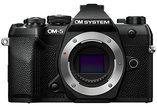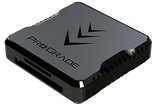
-
JOIN OUR WAITLIST
You've been added. Thank You!
×OM SYSTEM OM-1 Mark II Mirrorless Camera



4 Day Rental Price:
$135.00
The OM SYSTEM OM-1 Mark II Mirrorless Camera is a fast, versatile, compact Micro 4/3 camera with a powerful 20MP stacked CMOS sensor. It’s an update to the popular first-gen OM SYSTEM OM-1. Key features include:
-
20MP stacked CMOS sensor; TruePic X image processor
-
10 fps still shooting; 120 fps with electronic shutter
-
DCI/UHD 4K 60p 14-bit video capture
-
Improved autofocus and image-stabilization systems
What’s Changed? The OM SYSTEM OM-1 Mark II Mirrorless Camera includes a handful of improvements over its predecessor, the original OM-1. The autofocus system features new recognition modes, faster tracking performance, and an improved refresh rate. The revamped in-body image stabilization system is rated to deliver up to 8.5 EV of correction in testing, and boasts a 20% increase in stabilization. There are additional blackout-free shooting modes, a shooting buffer that’s roughly twice as deep as the one in the OM-1 Mark I, and 14-bit multi-shot RAW capture that triples the amount of tones in your images.
Still-Shooting Powerhouse. The OM SYSTEM OM-1 Mark II Mirrorless Camera offers continuous RAW or JPEG shooting at 120 fps when working with the silent electronic shutter and fixed focus, up to 50 fps with the silent electronic shutter and full AF/AE. With the mechanical shutter, you can reach up to 10 fps using AF/AE. The TruePic X image processor allows a native ISO range of 200 to 25,600, which is expandable to ISO 80 to 102,400.
Pro Capture Mode. Pro Capture Mode is basically a buffering system for stills. With a half-press of the shutter button, the camera starts taking full resolution JPEGs or RAW images. A full button press saves the current image and up to 99 previous frames. If you hold the shutter button in this mode, you can shoot continuously using the silent electronic shutter. There are three Pro Capture options, each suited to a different shooting situation. Standard Pro Capture mode, in which the camera shoots at up to 20 fps, is perfect for situations in which your distance from the subject will likely change during shooting. Pro Capture SH1 mode, which offers up to 120 fps shooting, works best for capturing subjects that’ll probably remain static. Finally, Pro Capture SH2 mode shoots at up to 50 fps and is only available with select lenses.
Creative Shooting Modes. There are four Creative Shooting Modes at your disposal, each of which serves a unique purpose. High Res Shot Mode composites a series of twelve shots into a single high-res frame in a mere five seconds. There are two High Res Shot Mode options: an 80MP mode, which requires a tripod, and a 50MP mode, which is tailored to hand-held shooting. The OM-1 II can capture 14-bit RAW-format images in both High Res Shot Modes, giving your photographs three times the tonal depth. Live ND Mode digitally simulates an optical ND filter to give you long exposure/slow shutter speed effects. Live Composite Mode builds up an exposure over time without overexposing elements within the frame, making it ideal for night shooting, light painting, and long exposures. Finally, Focus Stacking Mode automatically generates images with varied points of focus and combines them to produce an extended depth of field.
Simulated Neutral-Density Filter. This camera expands on its Live ND Mode by giving you the option to simulate a graduated ND filter. You can give the gradient a hard, medium, or soft edge, and one, two, or three stops of impact. The four-way control and touchscreen adjust the gradient’s midpoint, the front dial rotates the gradient by 15°, and the rear dial rotates it 1° at a time.
Video Workhorse. The OM-1 II supports DCI/UHD 4K capture at up to 60p and 10-bit 4:2:0, and it’s capable of recording Full HD at up to 240 fps for slow-motion playback. You can record in-camera time-lapse up to UHD 4K from 5 fps to 30 fps, you can use HLG picture mode for in-camera HDR recording, and you get 12-bit 4:2:2 RAW output via the micro-HDMI port when you’re using an external recorder. New to the Mark II is vertical video support, which broadens your shot-composition choices and makes post-production easier. You can use the built-in stereo mic to capture scratch audio, or you can use the 3.5mm external mic jack to record. There’s even a headphone jack included so you can monitor everything.
Improved Cross Quad Pixel Autofocus System. The on-sensor phase-detection Cross Quad Pixel autofocus system is an update to the one found in the original OM-1. It builds on its predecessor’s subject-detection system, gaining the ability to instantaneously track up to eight subjects by a broader array of types, and by details like animals’ eyes or race drivers’ helmets. It can also identify and track subjects who are in profile, fully facing away from the camera, or otherwise partially obscured. OM SYSTEM has also improved the AF refresh rate across the board. This system effectively splits each pixel into four pixels, which makes for very precise tracking even in poorly lit conditions. Its 1053 individual points fully cover the sensor and perform at up to 120 fps.
Image Stabilization. The five-axis sensor-shift image stabilization system accounts for 8.5 stops of shake in basically all directions, keeping your image rock solid when you’re shooting handheld. When paired with select lenses with optical image stabilization, the system can still compensate for up to 8.5 stops.
Built-In Wi-Fi and Bluetooth. Built-in Wi-Fi and Bluetooth offer simple connections to smartphones and tablets. This allows you to share images, view and download images, and make camera exposure and focus adjustments on the device while shooting, all via the O.I. Share app for iOS and Android.
Design, Memory, and Power. For framing and composition, there’s a 5.76m-dot OLED electronic viewfinder with 1.48x magnification and a 3.0-inch 1.62m-dot rear touchscreen LCD with 270° of swivel to let you shoot from just about any angle you’d like. The body is magnesium alloy, making it light and strong. The camera body is weather sealed and good in the cold down to 14°F. Dual UHS-II SD memory card slots give you flexible file management. The BLX-1 battery is rated for up to 500 shots per charge during standard operation and up to 1010 shots in Quick Sleep Mode. You can charge the battery in-body via the USB Type-C port.
This camera does NOT include a separate battery charger, it charges the battery in-camera with the supplied USB C cable and power adapter. If you need a separate external battery charger, please click here.
Q & A
-
This rental doesn’t include a paper copy of the manual, but you can view and download a PDF version here or under the "PDF Manual" section at the top of this page.
-
This rental doesn’t include the cable clip. If you’d like it, please request it in the Special Instructions box during checkout and we’ll include it with your order at no additional charge.
-
Pro Capture SH2 Mode’s 50 fps shooting only works with the OM SYSTEM M.Zuiko Digital ED 12-40mm F2.8 PRO, M.Zuiko Digital ED 12-40mm F2.8 PRO II, M.Zuiko Digital ED 12-100mm F4.0 IS PRO, M.Zuiko Digital ED 40-150mm F2.8 PRO, M.Zuiko Digital ED 150-400mm F4.5 TC 1.25x IS PRO, and M.Zuiko Digital ED 300mm F4.0 IS PRO.
Resources
| Brand |
OM SYSTEM |
| Camera Type |
Mirrorless |
| Environmental |
Operating Temperature
|
| Exposure Control |
Shutter Type
|
| Flash |
Built-In Flash/Light
|
| Focus |
Focus Type
|
| General |
Battery Type
|
| Imaging |
Sensor Resolution
|
| Interface |
Media/Memory Card Slot
|
| Item Type |
Camera |
| Mfr. Model Number |
V210040BU000 |
| Monitor |
Display Size
|
| Mount |
Micro 4/3rds |
| Sensor Size |
Micro 4/3rds |
| Still Image Capture |
Image Sizes – 4:3
|
| Video Capture |
Internal Recording Modes – H.264/MPEG-4 AVC
|
| Viewfinder |
Type
|

























